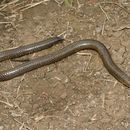en
names in breadcrumbs


Shield-tailed snakes (family Uropeltidae) are poorly studied fossorial snakes. There are 55 species in 8 genera. They are most closely related to Asian pipesnakes (Cylindrophiidae and Anomochilidae). The maximum size of the largest species is about 18" long, and some species have brightly colored undersides, especially on the neck and tail. They areendemic to mountain ranges in southern peninsular India & Sri Lanka, especially in thehigh-altitude 'shola' forests of the Western Ghats. Thanks to their doubly-supported skulls (both the atlas and axis contact the skull), their thick, myoglobin- & mitochondria-rich anterior trunk muscles, and unique method of burrowing (in which they simultaneously push the sides of the body against the tunnel walls and move the head forward, without pushing the rest of their bodies backward), they are capable of tunneling as deep as two meters through relatively hard soil. Their body scales shed dirt and their short, blunt, shield-like tails collect it behind them as they burrow. Most species eat earthworms, and they are eaten by other snakes, wild boars, mongeese, and predatory birds. They mate during the rainy season and females give birth to 3-9 live young at a time. It's likely that a high amount of diversity remains to be described, but continued habitat destruction and degradation throughout their range means that we may never know the true extent of uropeltid diversity.
The Uropeltidae, also commonly known as shield tail snakes, shield-tailed snakes or earth snakes,[2] are a family of primitive, nonvenomous, burrowing snakes native to Peninsular India and Sri Lanka. The name is derived from the Greek words ura ('tail') and pelte ('shield'), indicating the presence of the large keratinous shield at the tip of the tail. Seven or eight genera are recognized, depending on whether Teretrurus rhodogaster is treated in its own genus or as part of Brachyophidium.[2][3] The family comprises over 50 species.[2] These snakes are not well known in terms of their diversity, biology, and natural history.
Snakes in the family Uropeltidae are small snakes, with adults growing to a total length (including tail) of 20–75 cm (7.9–29.5 in). They are adapted to a fossorial way of life, which is apparent in their anatomy. The skull is primitive and inflexible, with a short, vertical quadrate bone and rigid jaws; the coronoid bone is still present in the lower jaw. The orbital bones are absent, the supratemporal is vestigial, and the eyes are small and degenerate, not covered by a brille, but by large polygonal shields. However, the pelvis and hind limbs, the presence of which is also considered a primitive trait, have disappeared in this family.[4]
The tail is characteristic, ending in either an enlarged rigid scale with two points, or more often an upper surface with a subcircular area covered with thickened spiny scales, or a much enlarged spiny plate. The ventral scales are much reduced in size.[4] The body is cylindrical and covered with smooth scales.
Many species of shield tail snakes are rather poorly known in terms of natural history. Field studies indicate that most species are obligate burrowers and may often come out on to soil surface during rainy nights. Even roadkills of these snakes have been recorded by field biologists during peak monsoon rains. They seem to prefer the humus-rich topsoil layers and rarely burrow deeper inside (like during very hot or dry weather).
When approached by predators, these snakes do not bite like most snakes, but coil their bodies into a ball and hide their heads tucked underneath. Some may poke with their harmless tail tip, like a worm snake. Many have a drab and dull-coloured back, but a very bright, contrastingly coloured underside (such as bright yellow, red, etc.) to startle predators by turning upside down and twitching. This aposematic colouration wards off would-be predators.[5]
Shield tail snakes are found in Peninsular India and Sri Lanka.[1] In India, their distribution is mainly along the hills of the Western Ghats, and a few species occur in other areas such as the Eastern Ghats and the hills of Central India. In Sri Lanka, they occur in many biotopes including dry zone and the plains.
Because of their peculiar geographic distribution, with many hill ranges in South India and Sri Lanka each having an endemic shield tail snake, they are thought to be analogous to Darwin's finches, in a broader sense – an evolutionary radiation.[6] This is the only family of snakes endemic to South Asia. Genetic studies on this group have brought forth largely similar results as regards common ancestry and phenotypic diversification patterns.[7][8] [9] Molecular dating analysis has suggested that uropeltids originated around the Paleocene-Eocene boundary, splitting from its sister clade Cylindrophiidae + Anomochilidae around 56 MYA.[9]
The diets of shield tail snakes consist mostly of invertebrates, particularly earthworms, and many species have actually been observed in the wild by researchers to eat earthworms. Frank Wall, who dissected many species for analysing the gut contents to study the diet, remarks about the presence of worms and mud.
All members of the family Uropeltidae retain eggs that hatch within the body of the mother (ovoviviparity).[10]
{{cite journal}}: CS1 maint: multiple names: authors list (link) The Uropeltidae, also commonly known as shield tail snakes, shield-tailed snakes or earth snakes, are a family of primitive, nonvenomous, burrowing snakes native to Peninsular India and Sri Lanka. The name is derived from the Greek words ura ('tail') and pelte ('shield'), indicating the presence of the large keratinous shield at the tip of the tail. Seven or eight genera are recognized, depending on whether Teretrurus rhodogaster is treated in its own genus or as part of Brachyophidium. The family comprises over 50 species. These snakes are not well known in terms of their diversity, biology, and natural history.